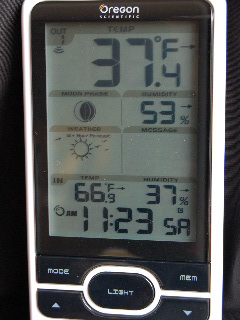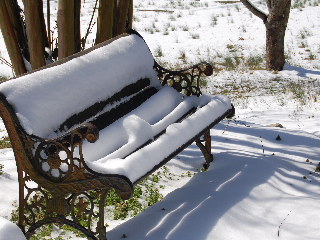
My grandfather, a life-long farmer and a very intelligent man, (see the article
Grandpa's Poetry) had only one piece of meteorological equipment to help him “measure” the weather—the weather that was and is so much a part of decision making and planning as related to the daily activities of gardening and farming.
The device he used was a rain gauge, and a homemade one at that. Actually, there wasn’t much “making” involved in his rainfall measuring instrument—he simply borrowed one of Grandma’s kitchen containers, sat it outdoors in an open area, and used a 12 inch ruler to measure the depth of its contents following a rainfall!
That was then and this is now—and, boy, have times (and the devices available to the home gardener) changed considerably!
We have the internet (you’re lookin’ at it!) so you can quickly access weather conditions anywhere in the world; we have the Weather Channel on cable TV, giving you ready access to past, present, and future atmospheric conditions in your area or on the Gulf coast where your brother and his family are vacationing. Want more?
How about your own personal home weather station, a convenient device giving you instant access to atmospheric conditions inside and outside your residence?
Setting up your weather station is almost as simple as borrowing one of Grandma’s kitchen pans, and the readings you get are a heck of a lot more detailed and accurate. Plus, you don’t even have to go outdoors to get those readings!
Your weather station consists of two parts, the first being the sensor that you place outdoors in a sheltered location out of the direct sun (this is the piece of equipment that gathers atmospheric information). The data is transmitted to the second part of your weather station, the indoor information center that displays the digital readings on a small computer-like screen. Both pieces of equipment are battery powered.
What kind of information will your home weather station give you? How about the current temperature and relative humidity (both outdoors and indoors), the high and low temperature and humidity readings for the past 24 hours, the current phase of the moon, the time, and the precipitation forecast for the next 12 hour time period?!
Also, the trends (rising or falling) for temperature and humidity; even a message center advising you of potential fog or freezing conditions in your area!
What (you may ask) do you need all this for, especially since, as we’ve earlier noted, you can access most of this information on your computer or cable TV? First of all, if you’ve just gotten up and are preparing for the day, you can see current conditions via a quick glance at your own weather station without lifting a finger to turn on any electronic devices (we’re assuming all your fingers are already pretty busy with morning prep of breakfast, getting dressed, and readying the kids for their journey into the coming day).

Check your home weather station (instantly!) and you’ll know the current temperature, the rising or falling trend, the prediction of clear skies or precipitation. This will give you a pretty good idea of whether your family needs light jackets, heavy jackets, no jackets, (or raincoats and umbrellas) to engage the day!
You might also have a good indication of whether soccer or baseball practice will be held after school, or whether or not you’ll have favorable conditions to do some afternoon gardening.
The indoor readings from your weather station can also give you a pretty good idea of how your home heating and cooling system is performing on an around-the-clock basis. Should the thermostat be adjusted more over the course of the 24-hour period?
Depending on your wants, needs, and desires (and your budget, of course), other more sophisticated home weather stations, which measure even more atmospheric variables, can be purchased.
Some models feature an outdoor sensor that measures the rainfall and sends the data to your indoor information station, giving you an accurate reading of precipitation amounts—no rulers or kitchen containers required!
I think Grandpa would have really liked this model; Grandma would’ve been pleased, too!
 My grandfather, a life-long farmer and a very intelligent man, (see the article
My grandfather, a life-long farmer and a very intelligent man, (see the article  Check your home weather station (instantly!) and you’ll know the current temperature, the rising or falling trend, the prediction of clear skies or precipitation. This will give you a pretty good idea of whether your family needs light jackets, heavy jackets, no jackets, (or raincoats and umbrellas) to engage the day!
Check your home weather station (instantly!) and you’ll know the current temperature, the rising or falling trend, the prediction of clear skies or precipitation. This will give you a pretty good idea of whether your family needs light jackets, heavy jackets, no jackets, (or raincoats and umbrellas) to engage the day!